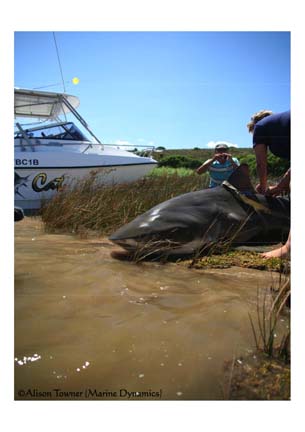Photos of the Bull shark (Carcharhinus leucas), from South sea and Walker´s Cay/Abaco islands/Bahamas by Klaus Jost.
| Photo | Reference | Sex | TL (m) | W (kg) | PCL (m) | Comments |
|---|---|---|---|---|---|---|
| Clark and von Schmidt (1965) | 2.55 | 173 | Largest one in Clark and von Schmidt (1965, Bulletin of Marin Science). | |||
| Neer et al. (2005) | M | 2.02 FL | Largest male in Neer et al (2005, J Fish Bio 67:370-383). Estimated to be 25 years old. | |||
| Neer et al. (2005) | F | 2.23 FL | Largest female in Neer et al (2005, J Fish Bio 67:370-383). Estimated to be 29 years old. | |||
| Bass et al (1973) | M | 2.71 | Largest male in Bass et al (1973, Invest Report #32, p. 23, Table 1) | |||
| Bass et al (1973) | F | 2.86 | Largest female in Bass et al (1973, Invest Report #32, p. 23, Table 1) | |||
| Wintner et al (2002) | 2.21 | Largest one in Wintner et al (2002, Mar Freshwater Res 53:557-566). Estimated age 32 years | ||||
| Wintner et al (2002) | 3.00 | 2.34 | Largest captive bull shark at Sea World in Durban. Grew 81.5 cm TL in 12 years | |||
| 24 Mar 2025 | Helmut Nickel | 316.5 | The IGFA-All Tackle Bull Shark Record is for a 697lb 12
oz specimen, caught off Malindi Kenia on 24 March 2025 by Ronald de Jager. |
|||
| Compagno 1984 | 3.4 | Max. size according to Compagno (1984) is 3.4 m. Males maturing at 1.57-2.26 m and reaching at least 3.0 m; females maturing betweeen 1.8-2.3 m and reaching at least 3.24 m. Size at birth between 0.56-0.81 m. Numbeer of young per litter is 1-13 born in late spring to early summer. | ||||
| Dave Ebert | ~3.5 | Malcolm Smale caught one (or measrued one) that was about 3.5 m TL off Sunday’s river mouth or somewhere along that stretch of coast. | ||||
 23 Jan 2025 |
Hennie Papenfuss via Steve Faulconer and Allen Andrews | F | 4.0 | 575-600 | 3.2; 0.85 IDL | From Steve Faulconer <[email protected]>:
I write to give you the details of our research expedition to the Breede
River during the week January 19-25. The purpose of the expedition was
to determine whether reports of Zambezi (bull) sharks in the Breede River
could be confirmed. Scientifically, confirmed reports would be extremely
relevant on a global scale as this would represent the most south-westerly
distribution of bull sharks in Africa. Joining us on the expedition was Dr. Steve Lamberth and his team from MCM, Hennie Papenfuss from Big Fish Safari and a team of four from SASC. We fished for 3 days with no luck & were rewarded on the 4th day when Hennie caught a bull shark on his line. After an hour and a half struggle with the fish (during which it towed him2.5km further upstream), Hennie managed to tire her enough to bring her close to shore for landing. Our team then brought her carefully to the shore, where we were able to collect all the required data. We measured her, tagged her with two acoustic continuous tags and one spaghetti tag, and gathered genetic samples in order to determine whether bull sharks in the Breede River represent a distinct population from those found elsewhere in South Africa. She is a world-record breaking shark measuring 4 metres total length, weighing in the vicinity of 550-600kg. This is the largest bull shark known to science - the previous maximum size was thought to be 3.5 metres TL. We also suspect she was heavily pregnant and may very well be using the Breede as a pupping ground. Following the tagging, we proceeded to track her for 43 continuous hours. She spent the majority of the time in the estuary, with only a few hours in the surf zone just outside the river mouth. Paul Cowley received a short note to review. It highlights (i) its size, (ii) South African distributional range extension and (iii) movements (based on 43 hrs of manual tracking). It will be published in the African Journal of Marine Science. |
12 Mar 2025 |
Elasmo-L posting by Randall Arauz | F | >4.0 | LARGE BULL SHARKS OBSERVED NEAR
COSTA RICA’S SOUTHERN PACIFIC COAST Researchers Record Larger than Expected Adult Bull Sharks along Costa Rica’s Osa Peninsula, and tag 4 juveniles in the mouth of the Sirena River, Corcovado National Park. March 12, 2009, San José, Costa Rica—Shark researchers from the Costa Rican organization Pretoma made a startling observation last week while studying bull sharks (Carcharhinus leucas) at the mouth of the Sirena River, in Corcovado National Park—specimens over 4 meters in length (12+ feet). The researcher’s long-line fishing gear, rigged to catch smaller pelagic sharks, proved inefficient in catching the larger coastal bull sharks. “We didn’t expect to encounter sharks this size”, said Randall Arauz, the expedition’s Scientific Director. “Many of the hooks and steel leaders were mangled, destroyed, or simply bitten off by the large animals, only one of which came close enough to our fishing vessel for us to take a glimpse of its amazing size, before it too broke free”, said an astonished Arauz. |
||
| Photo | Reference | Sex | TL (m) | W (kg) | PCL (m) | Comments |